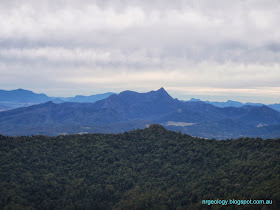In the last few months I had a trip to Coffs Harbour where I was able to walk along some of the lovely beaches. On Diggers Beach I noticed a strange looking band through the exposed face of a dune system that had been recently been eroded away by stormy seas. Upon closer inspection the band was a layer of fine gravel and shell fragments. Underlying this layer of gravel and shell was sand with some isolated gravel which graded into the previous layer. The top of the layer was distinct and comprised of fine well-sorted sand, typical of a dune system. I noted another exposed gravel layer about 50 metres further south along the beach at roughly the same height.
 |
| Evidence of a palaeo-beach on present day Diggers Beach. |
The height of the palaeo-beach seems to indicate that maybe it was formed by a higher sea level, or a lower ground level. Tectonically eastern Australia has been very stable for millions of years so I think it unlikely that the earth has been uplifted. The most likely explanation in my mind is that the sea level was higher.
Thom & Roy (1983) suggested that Holocene sea levels have been very stable. However, sea levels varied in the time period before the Holocene. The Pleistocene sea levels were much higher and much lower than today. In the Pleistocene on north coast NSW sea level variations were first documented in detail by authors including Den Exter (1974) and Drury (1982). The apparent Holocene sea level low-fluctuation and high-stability of Thom & Roy (1983), if true, would be an aberration.
Baker et al (2001b) used fixed biological indicators to attempt to reconstruct Holocene sea levels. Baker et al (2001b) dated the remnants of tubeworms, barnacles and oysters that occurred above their natural ecological limit (i.e. above the intertidal zone). These indicators can be used to trace sea level changes. Baker et al (2001a & 2001b) undertook this work up and down eastern Australia and compared them with other sites including those in Brazil. The resulting information showed that Holocene sea levels have not been as stable as first thought. The sea level changes have been shown by earlier authors (e.g. Thom & Roy 1983) to occur during periods of known palaeo-climate change.
According to Baker et al (2001a & 2001b) the last time the sea level was 1 metre higher than present was around 2400-1800 years ago. Maybe, the layer is a preserved berm from a beach that existed at the time of the Roman Empire (sometimes referred to as the Roman Warm Period). I don’t know for sure, but to my thinking it seems quite plausible.
References/bibliography:
*Baker. R.G.V, Haworth, R.J. & Flood, P.G. 2001a. Inter-tidal fixed indicators of former Holocene sea levels in Australia: a summary of sites and a review of methods and models. Quaternary International v83-85 p247-273.
*Baker. R.G.V, Haworth, R.J. & Flood, P.G. 2001b. Warmer or cooler late Holocene marine palaeoenvironments? Interpreting southeast Australian and Brazilian sea-level changes using fixed biological indicators and their d18O composition. Palaeogeography, Palaeoclimatology, Palaeoecology v168 p249-272.
*Den Exter, P. 1974. The coastal morphology and Late Quaternary evolution of the Camden Haven district, NSW. Australia. PhD Thesis, University of New England, Armidale.
*Drury, L.W. 1982. Hydrogeology and Quaternary stratigraphy of the Richmond River valley, New South Wales. PhD Thesis. University of New South Wales. Kensington.
*Thom, B.G. & Roy, P.S. 1983. Sea Level Change in New South Wales over the past 15 000 years. In: Hopley, D. Australian Sea Levels in the Last 15,000 Years: a review. James Cook University, Townsville.
